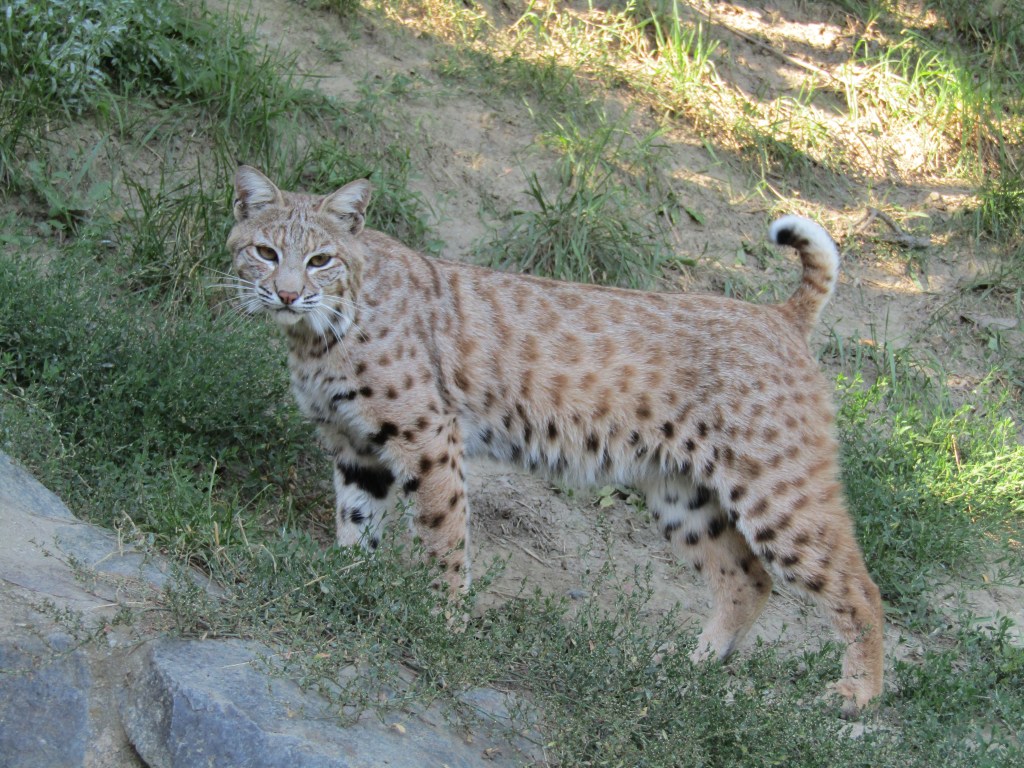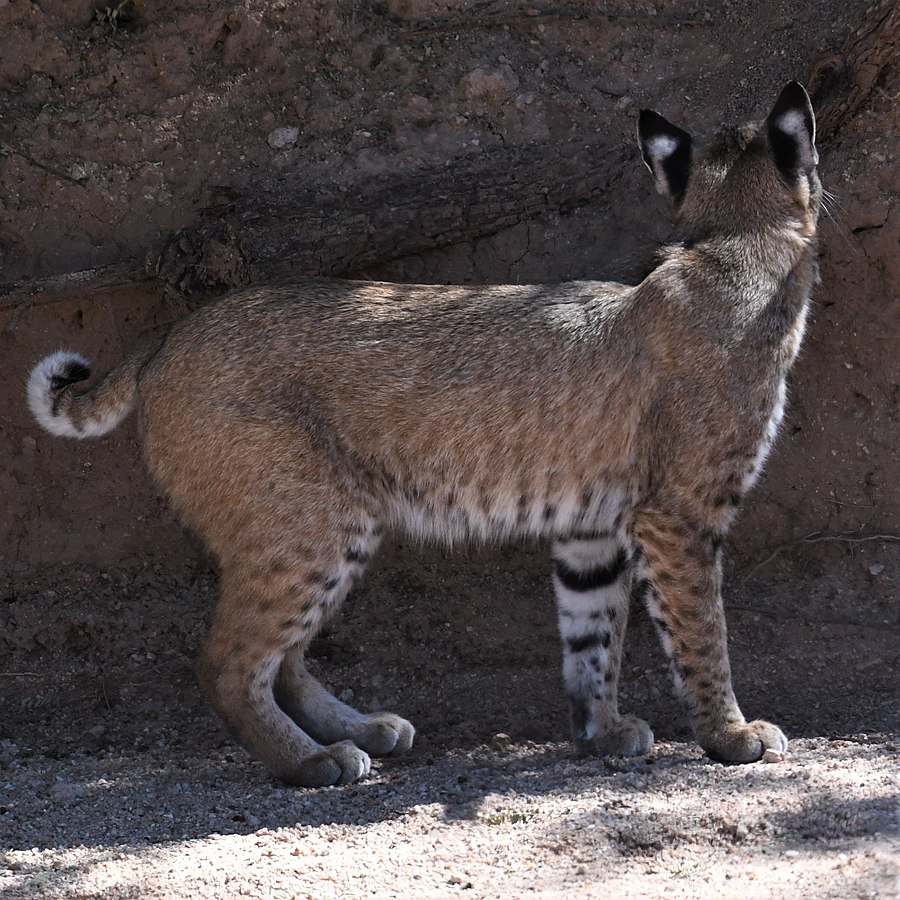While getting the mail at twilight recently, I was treated to a rare sight…a Bobcat (Lynx rufus)! It crossed the middle of the road about 25 yards (23 meters) away and stopped to stare at me. I heard cars approaching and didn’t want it to be hit, so I walked briskly toward the cat and it ran off into the woods. Some cats have learned to look both ways before crossing roads. Even so, car strikes are one of the leading causes of Bobcat mortality.

During the 1800s, Bobcats were rarely seen. Populations were probably quite low because of the widespread clearing of New England forests for sheep farms and charcoal production. Connecticut had a state bounty on these cats until as recently as 1971, but hunting and trapping seasons were discontinued over concerns that the species was facing extirpation. In 1972 the Bobcat was listed in Connecticut as a protected furbearer. As the forests grew back and hunting pressure abated, Bobcat populations have gradually rebounded.
Bobcats are medium-sized, stout-bodied felines about two to three times the size of a domestic cat. Males usually weigh from 18 to 35 pounds (8 to 16 kilograms) and are 32 to 37 inches (81 to 94 centimeters) long. Females are smaller at 15 to 30 pounds (7 to 14 kilograms) and 28 to 32 inches (71 to 81 centimeters) long. These cats are gray to tan on their sides, with faint black spots. Bobcats are named for their short “bobbed” tail.

Bobcats are polygamous (have more than one mate) and do not form lasting pair bonds. They mate in February and March and females raise the young, giving birth to one to four kits in April. Dens are located under fallen trees, in caves, on ledges, and in hollow logs.
For the past few years, Connecticut Department of Energy and Environmental Protection wildlife biologists have been studying Bobcats using radio telemetry. Cats are trapped, anesthetized, and fitted with GPS collars. Biologists had questions about Bobcat movement and home ranges as well as food preferences—and have discovered some surprising things. One female made a den next to an interstate. Bobcats are often hunting in woods near houses, but are so quiet that they are rarely seen.

By examining the stomach contents of road-killed animals, Connecticut DEEP biologists have found that Bobcats prey mostly on the Cottontail Rabbit (Sylvilagus floridanus), Eastern Gray Squirrel (Sciurus carolinensis), and American Red Squirrel (Tamiasciurus hudsonicus). Bobcats also hunt woodchucks, chipmunks, mice, voles, White-tailed Deer (Odocoileus virginianus—usually old, sick, or young animals), birds, insects, and reptiles. On occasion, they may also take small livestock and poultry, as well as unsupervised house cats. Other than making them potential Bobcat prey, it is never a good idea to let pet cats roam outside where they can contract the deadly feline leukemia virus. In the United States, free-roaming domestic cats kill up to 3.7 billion songbirds each year. Do Bobcats attack humans? Attacks on people are extremely uncommon and Bobcats rarely carry rabies. Bobcats should not be harmed.
In the last few years more people have reported Bobcat sightings. Despite increased development, populations in Connecticut now seem to be holding their own. Bobcats are very adaptable to living in a variety of habitats. They like mixed hardwood–coniferous forests, but seem to prefer younger forests with wetlands and brushy areas, or brushy woodlands with nearby fields.
Increasing urbanization, however, is fragmenting habitats. Bobcats in New England have a home range of 8 to 20 square miles (20 to 52 square kilometers). But animals in these fragments often are the most restricted in their movements, resulting in reduced natural genetic diversity. Preserving open space and providing wildlife corridors that connect available habitats are key to having these majestic animals with us for generations to come.
Lucky you for meeting one! Thanks for preventing a possible car strike, Jim.
Great post, as always.
LikeLike
Thanks Cheryl!
LikeLike
Very interesting post, Jim. I’m glad you were able to scare it off the road, so it wouldn’t get hit. Nicely written. Well done!
LikeLike
Last month we had four young deer in our back yard. It was early morning. The deer moved on, and within a few minutes three bobcats emerged from the brush and followed the deer. It was my first bobcat sighting ever, and I’ve lived in Connecticut for 77 years. I think the bobcats were siblings from a litter born this year, but that’s a guess n my part. This was in North Haven, off Clintonville Road.
LikeLike
That’s neat Peter!That sounds like they were young from a litter and still with their Mom.
LikeLike
I have seen some in our yard in Bethany over the years. They have never been any problem!
LikeLike
That’s great Bill that you’ve seen some. We all need to educate the public that bobcats are not dangerous and harmful. Thx!
LikeLike
One summer evening my husband and I were having dinner on the deck (Orange) and a bobcat strolled through the middle of our backyard. It was an amazing sight. It had pointy ears and a very muscular body. Looked our way and then just kept strolling.
LikeLike
Nice siting Donna, beautiful animals, eh? Best, Jim
LikeLike
Great read Jim! Knowing this, I am now cool with cats!
LikeLike
That’s great to hear Pat! Thx!
LikeLike
I have seen them in Bloomfield- lovely cats!
LikeLike
Glad you have Barb – totally agree!
LikeLike
Yes, totally beautiful. Based on your article I think it was a male, looked to be on the bigger end of the scale.
LikeLike
Hi Donna, sounds like a male to me, thx! Jim
LikeLike
This is a fascinating article on one of our state’s most elusive animals! Thanks, Jim! A few years ago (late summer, in the late afternoon), I was about to go into our vegetable garden to harvest, when I saw a bobcat stroll past 20 ft. from me on the opposite side of the garden. Imagine my surprise! The bobcat kept walking calmly into the front yard and across the street into the neighbor’s yard (Trumbull). The cat had a beautiful, healthy coat and was probably a male (size). The next day we found bobcat scat in the yard (based on descriptions and photos in tracking guides we have). My guess is that he spent some time hunting for rodents in this area before moving on. Now I always check for tracks and scat to see if another bobcat is in the area.
LikeLike
That’s really neat that you got such an up close and personal view Linda! Thx for sharing and your kind words, All best, Jim
LikeLike
Hi Jim, Great article. I live in Guilford and have seen Bob Cats in my yard for years. Last week a male came really close to my back door of the house. They are amazing animals to watch, and take pictures of. I have a few and a video if you ever want to see them. Thanks.
LikeLike
Thanks Vanessa! That’s so great you had them come up so close and got photos and a video. A rare opportunity.
All best,
Jim
LikeLike
My daughter in law get a bob cat every now and then in her yard! Always in the same spot. She lives on the Hartford Turnpike in North Haven. The kids always want to pet it but she won’t let them near it. Are they dangerous near children. Their ages are 11 and 7
LikeLike
Hi Deb, Bobcats as a rule don’t bother humans. But as a wild mammal there can be a rare instance when they can carry rabies. Again, extremely rare. Being wild animals they would normally flee when approached and your daughter-in-law is right to have her kids just observe it and not approach it in case it the animal feels threatened.
LikeLike
Very interesting post on these elusive and beautiful cats — thank you! We’ve seen more here in Burlington in recent years. I haven’t actually seen one in several months, but their tracks in the snow show me that they’re around.
LikeLike
Yes Ned, they are so elusive. Tracks are a good way to know they have been around.
LikeLike
Great article Jim! I am quite partial to wild cats. We are very lucky to have a wild cat species in CT. So glad bobcat numbers are up in CT and they seem to be thriving. It’s not that way for other big cat species, worldwide. The DEEP is doing good work on our local species. I look forward to hearing more about the DEEP Bobcat project in the future. I was lucky enough to see two bobcats in the last few years. One right off and I91 exit in Wallingford, and the other, bounding across my street a few house down from me. Hope to see more!
LikeLike
Hey Carolyn, It’s a real thrill to see them and I am glad they are doing OK for now. Best, Jim
LikeLike